Thien Mu Pagoda: The Oldest Temple in Hue City
Nestled atop a hill with a hidden dragon position, Thien Mu Pagoda, also known as Linh Mu Pagoda, is a historic and vital religious site in Hue City, Vietnam.
With its harmonious feng shui setting, this sacred place embodies the spiritual essence of Buddhism and draws visitors from around the world.
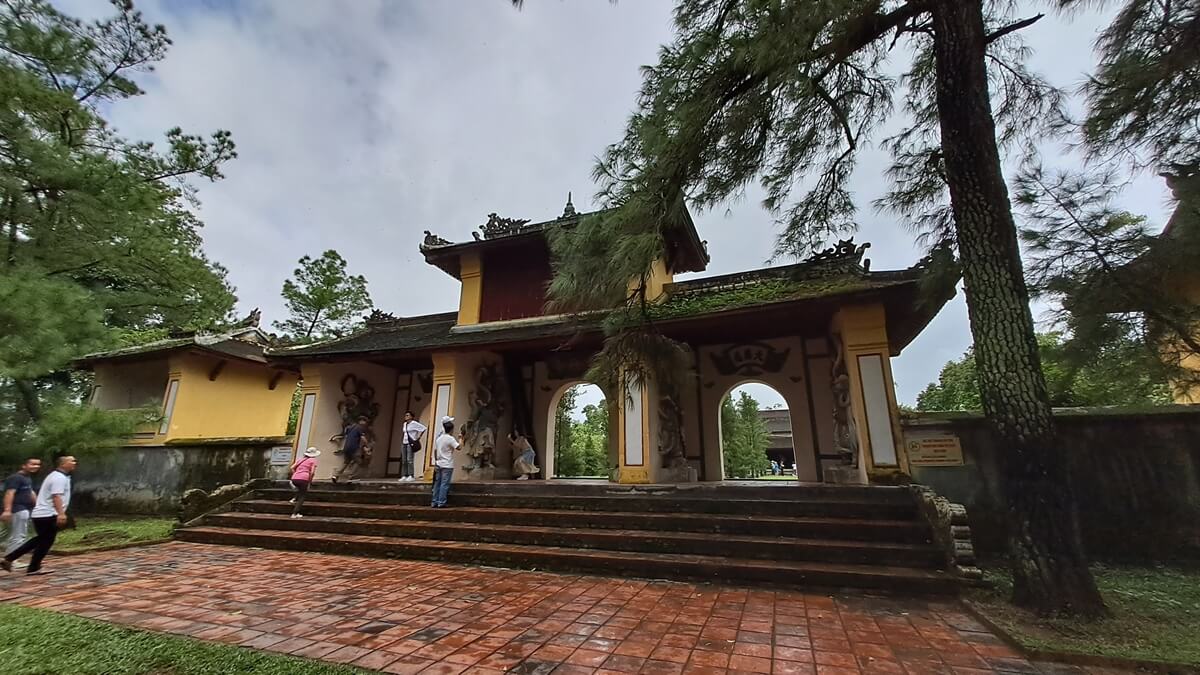
1. Where is Thien Mu Pagoda located:
Recognized as the oldest temple in the city, it lies 5km west of the center, overlooking the tranquil Perfume River.
The pagoda is located on Nguyen Phuc Nguyen Street, Huong Hoa District, Hue City, Vietnam, and does not have a specific address number.
Thus, you may find on the map the coordinates: 16.453172149577, 107.54489981329543
Google map shows the correct place of Thien Mu Pagoda.
How to get here:
It is convenient to visit the temple by dragon boat along the tranquil river. Relaxing and feeling the cool air takes around 40 minutes from the city center.
Also, car use is a popular choice for many international tourists, who prefer to run on the big streets for faster movement.
Tip: Visiting Thien Mu Pagoda and Hon Chen by boat can maximize your experience of Hue City's spiritual and historical richness.
2. The legend of Thien Mu Pagoda
Long ago, the natural area around Ha Khe Hill was dense with dangerous wild forests. A modest temple on this hill was a sacred place where the locals worshipped. In this tranquil setting, the legend of Thien Mu Pagoda began to take shape.
In 1601, while journeying from the North to the region of Phu Xuan (modern-day Thua Thien Hue) to establish a new capital and fortune, Lord Nguyen Hoang stopped to rest on Ha Khe Hill.
As he slept, he had a vivid dream: a woman dressed in a red shirt and blue pants appeared to him, standing atop the hill. She spoke with profound clarity:
"There must be a lord to build a pagoda here to gather sacred energy to maintain the dragon's power. Hold incense sticks and walk along the riverbank until the incense burns out. This will be the place where your capital should be."
Upon awakening, Lord Nguyen Hoang was moved by the vision and followed the woman's advice. He traveled along the riverbank with incense in hand as the agarwood fragrance lingered in the air. Once the incense burned out, he knew that he had found the perfect location for his new capital. This land would later become the site of the majestic Imperial Citadel, which endures to this day.
Inspired by this divine guidance, Nguyen Hoang expanded the area of Ha Khe Hill and constructed a grand pagoda to honor the Buddha. Initially named "Thiên Mụ" or "Heavenly Lady," the pagoda's name was later changed to "Linh Mụ" (Holy Lady) during the reign of King Tu Duc, who feared that the word "Thiên" might offend the heavenly powers.
Today, the locals use both names- Heavenly Lady and Holy Lady- interchangeably.
Over the centuries, Thien Mu Pagoda has remained a sacred spiritual sanctuary, where the people of Hue come to pray for peace, prosperity, and blessings for their families and loved ones.
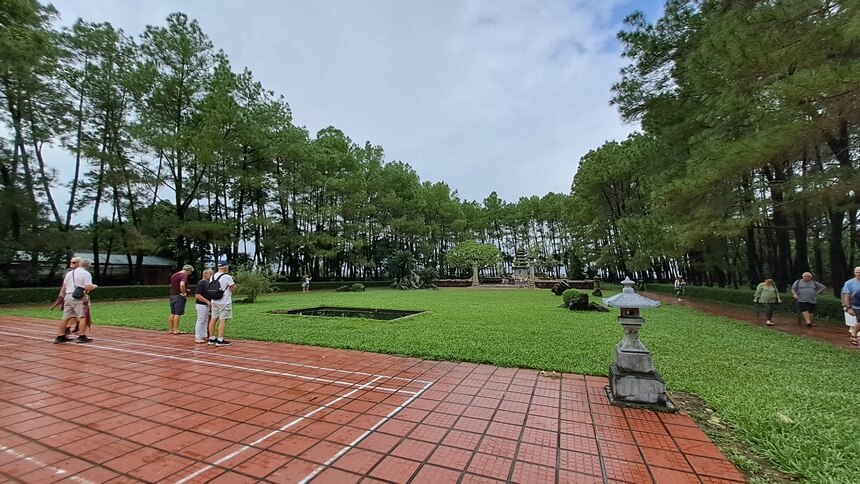
3. Thien Mu Pagoda Architecture
The pagoda follows a straight-line structure called I-shaped architecture, meaning that the main architectural works are located on a straight axis of the plane on Ha Khe Hill. Supporting architectural works are on both sides.
We can see specifically as follows:
3.1. Four pillars:
At the front, four pillars near the path are built with cement larger than a person's embrace, forming three entrances called the three-entrance gate. Unlike other three-entrance gates with roofs, this gate is left empty, showing the connection between heaven, earth, and people.
The pillars follow the minimalist style of architecture, so they have a few patterns on their bodies. On top of each pillar is only the image of the lotus flower, a notable Buddhist symbol.
3.2. Phuoc Duyen Tower and surrounding works
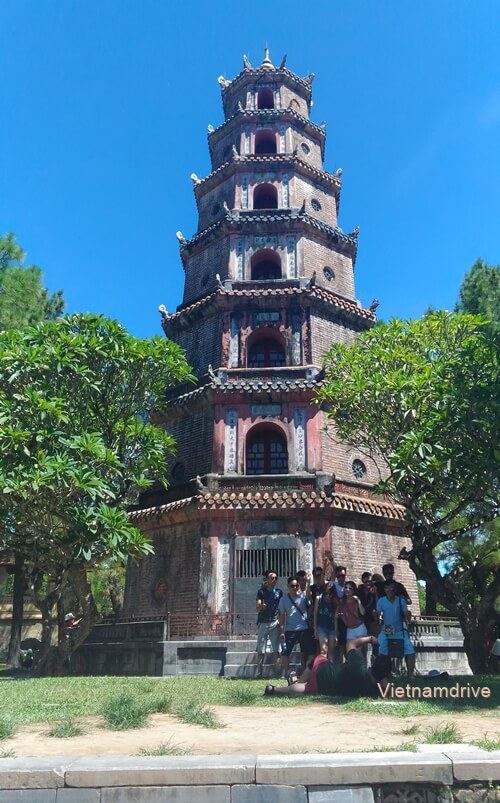
Looking up from the three-entrance gate is the 7-storey Phuoc Duyen Tower, an octagonal structure reaching high, like rising the blue sky. The tower has gradually smaller floors from the base to the top, symbolizing steady development. Each floor is dedicated to worshiping a Buddha.
The decorative details are also simple. Dark colors are used throughout, contrasting with the white background of Chinese characters on both sides of the door frames of each floor, highlighting the solemnity and sacredness.
On both sides of Phuoc Duyen Tower are two notable small towers:
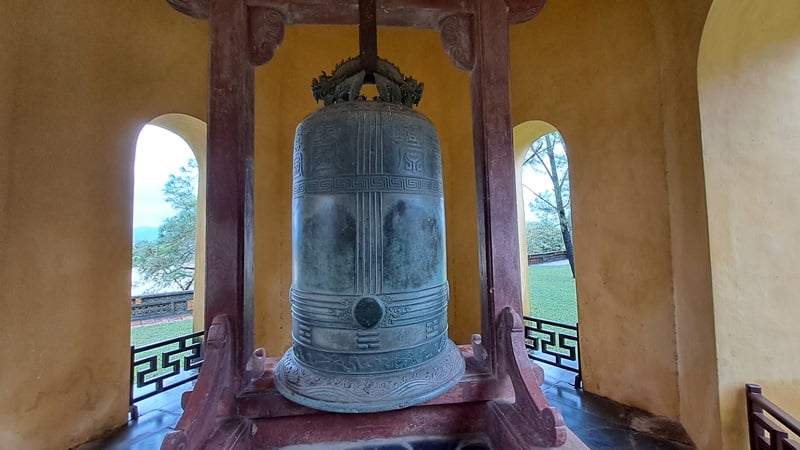
- On the right is the bell tower, with Dai Hong Chung cast in 1710, during the reign of Lord Nguyen Phuc Chu. The bell weighs more than 2000kg, is 2.5m high, has a mouth diameter of 1.4m, and has many exquisite patterns engraved on its body and a dragon on the bell belt. The bell once had a sound that echoed far away and was said to be able to carry prayers throughout the region, across the other side of the Perfume River.
- On the left of the tower is a large turtle statue. On its back is a stele engraved with Chinese characters describing the history and formation of the temple. Many people believe that touching the turtle's head here will bring good luck, so its head becomes shiny. However, currently, the temple does not allow visitors to touch it, so you should pay attention to this.
3.3. Dai Hung Dien:
Located in the heart of the temple area is Dai Hung Dien, built in 1601 by Nguyen Hoang King, the most prominent architectural work here. Although damaged and restored many times, the shrine still retains its ancient features, including a yin and yang roof, a gently curved roof with stylized dragons, and Buddhist reincarnation circles, which remind us of the progress, destruction, and rebirth of life.
Inside the shrine is a bronze statue of Maitreya Buddha with a big belly, smiling brightly and welcoming everyone to the land of Buddha. Around it are shiny, lacquered, unpainted wooden pillars, creating a substantial but modest look.
In general, the overall decoration in the architecture of Thien Mu Pagoda shows a nostalgic look, with the simple, dark colors used in the design and decoration, with only a few decorative patterns. However, this place still shows the elements of honoring Buddhism with gentle lotus flowers, the Buddhist reincarnation cycle on roofs, or the minimalist dragon image on the temple roof - showing humility, utterly different from the elaborate, powerful dragons in the Royal Palace.
Besides these main architectural works, many places are waiting for you to explore, such as Dia Tang Temple, Quan Am Temple, Bonsai Garden, or an Austin antique car item.
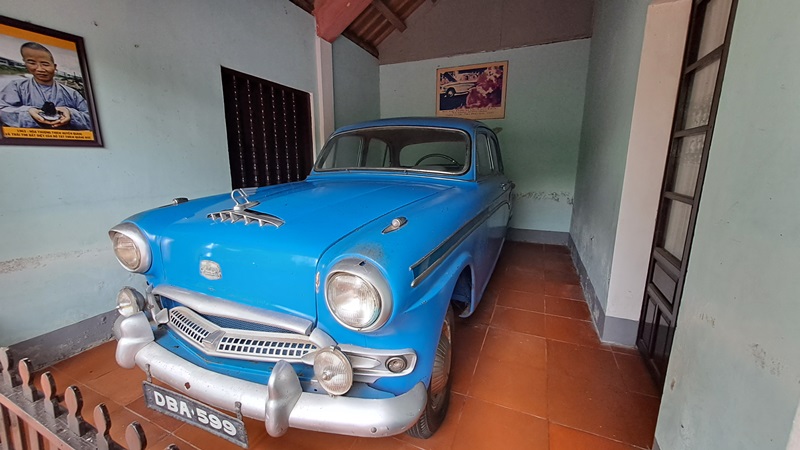
4. The historical significance of the pagoda
The birth of Thien Mu Pagoda marked a foundation for the development of Buddhism in Hue and Vietnam. Following this development, Hue City has more than 300 pagodas (source) scattered throughout the city and in tranquil mountains, making this land a Buddhist center in Vietnam.
Another remarkable thing about the pagoda is that it witnessed the prosperity of the Nguyen Dynasty, which lasted throughout the 19th and early 20th centuries. The Nguyen Dynasty kings' strong belief in Buddhism also created favorable conditions for the gradual establishment of Thien Mu Pagoda and other pagodas here.
Today, this pagoda has become one of the most popular attractions in Hue City, drawing hundreds of tourists from Vietnam and around the world daily.
5. Note when going to Thien Mu Pagoda
Visiting Thien Mu Pagoda, as well as other temples in Hue, you should pay attention to:
- Its dress code does not allow crop tops or tank tops, and pants or skirts that are too short or above the knee are also prohibited when entering the central area and worshipping temples.
- Please choose polite daily clothing to ensure solemnity when coming here.
- Keep your vehicle inside the designated parking area. You may be fined.
- Do not automatically ring the bell or write on walls or decorations at the temple.
- You should walk lightly and speak softly. Take photos comfortably, but do not pose in strange positions.
- At noon, around 11 am – 1 pm, the main temple is often closed for lunch. If you want to pray, pay attention to this time to arrange a suitable trip.
- The best times to visit and take stunning photos at Thien Mu Pagoda are early morning, before 8:00 a.m., and late afternoon, after 4:00 p.m. During these hours, the soft, golden light enhances the pagoda's beauty, creating dramatic shadows and a peaceful atmosphere.
-
Allowed to take pictures
-
Bike Parking
-
Parking Section
-
History & Culture
